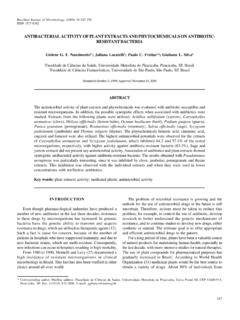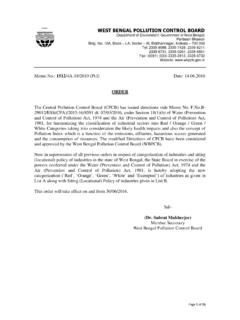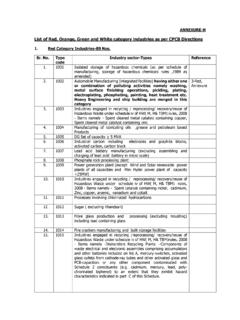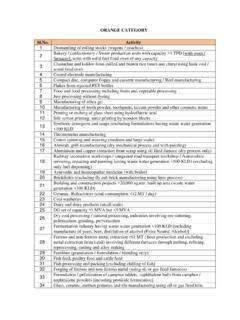Transcription of CHARACTERIZATION AND USE OF AND CALCINED …
1 Brazilian Journal of Chemical ISSN 0104-6632. Printed in Brazil Engineering Vol. 29, No. 03, pp. 619 - 633, July - September, 2012. CHARACTERIZATION AND USE OF IN NATURA. AND CALCINED rice HUSKS FOR. BIOSORPTION OF HEAVY METALS IONS FROM. AQUEOUS EFFLUENTS. M. G. A. Vieira1*, A. F. de Almeida Neto1, M. G. Carlos da Silva1, C. C. N brega2 and A. A. Melo Filho2. 1. State University of Campinas (UNICAMP), School of Chemical Engineering, (FEQ), Department of Processes and Products Design (DDPP), Phone: + (55) (19) 3521-0358, Fax: + (55) (19) 3521 3965, Av. Albert Einstein, 500, Cidade Universit ria Zeferino Vaz , CEP: 13083-852, Campinas - SP, Brazil. E-mail: 2.
2 UFRR/DQ, Boa Vista - RR, Brazil. (Submitted: April 8, 2011 ; Revised: January 23, 2012 ; Accepted: February 23, 2012). Abstract - Heavy metal removal by adsorption using rice husks as a bioadsorbent was evaluated as an alternative for wastewater treatment. Batch equilibrium experiments and kinetic sorption studies were performed using monocomponent solutions of Ni(II), Cd(II), Zn(II), Pb(II) and Cu(II) in surface samples of in natura (RH) and CALCINED rice husks (RHA). RHA showed higher potential for removing lead and copper. Experimental data for adsorption isotherms of lead and copper were adjusted by Langmuir, Freundlich and Dubinin-Radushkevick (D-R) models, being better represented by the Langmuir model.
3 The calcination of RH increased its surface area, improving its adsorption properties. From a morphological analysis obtained by SEM and diffraction patterns (XRD), a longitudinal fibrous and amorphous structure was observed for RH. TGA results indicated a total mass loss of around 60% for RH and for RHA. Keywords: rice husks; Heavy metals; Biosorption. INTRODUCTION in research in order to transform them into commercially interesting by-products. Industrial and domestic effluents, as well as rice is one of the most commonly grown and indiscriminate application of pesticides/herbicides to consumed grains in the world. It is considered to be crop fields have contributed to the deterioration of the most economically important product in many environmental quality.
4 Among these pollutants, developing countries, being a staple food for billions heavy metals represent a special group because they of people. World production for the 2008 crop was are not chemically or biologically degraded in a million tons (Fao, 2010). Brazil ranks 10th in natural manner. the production of this cereal. Nowadays, with the aim of reducing waste During the processing of rice , the most residue generation in industrial and agricultural voluminous by-product is husks, which represent processes and improving reuse of these in the about 20% of rice weight. rice husk (RH) is a production process, companies are investing more fibrous material, composed mainly of cellulose, *To whom correspondence should be addressed 620 M.
5 G. A. Vieira, A. F. de Almeida Neto, M. G. Carlos da Silva, C. C. N brega and A. A. Melo Filho lignin and inorganic and organic compounds. rice The surface area and volume of the pores were husk ash (RHA) is a light material, bulky, porous obtained by N2 physisorption at 77 K. These and amounts to about 20% of the burnt husk. analyses were performed with a Micromeritics Several technological alternatives have been Gemini III 2375 Surface Area Analyzer using the associated in the literature with the use of RH and BET method. RHA: production of silica and silicon carbide, using X-ray diffraction powder patterns for the the ashes like filler in polymers, in concrete, identification of particular peaks and to confirm the production of silicates, zeolite synthesis (Chumee maintenance of its properties after calcination were et al.)
6 , 2009) and use as an adsorbent of heavy metals obtained with samples in powder form (< mm), in synthetic wastewater (Srivastava et al., 2006; copper K radiation, voltage 40 kV, 40 mA current, Naiya et al., 2009; Krishnani et al., 2008; Tarley and step size of , step time of 1s and 2 range of Arruda, 2004; Ye et al., 2010; Bhatnagar and 3 50 . The FTIR studies were carried out using a Sillanpaa, 2010; Ahmaruzzaman, 2010). Bomem-MB102 spectrometer (ABB-Bomem). The The use of RH for the sorption of metals in spectra were acquired in the range of 4000 to aqueous solution has been recently discussed due to 400 cm 1 at a resolution of 4 cm 1. its low cost, abundance, easy availability and Thermal analyses (TG, DTG and DSC) were possibility of reuse (Vieira et al.
7 , 2011; Kumar et al., carried out on a Shimadzu TGA-50 in a N2. 2010, Giraldo and Moreno-Piraj n, 2008). Studies on atmosphere (50 mL/min) at a heating rate of metal removal using different adsorbents, such as 10 C/min. The samples were put in platinum pans clays (Vieira et al., 2010 a, b; Jiang et al., 2009), and scanned from room temperature to 1000 C. zeolites, sugarcane bagasse and other materials Helium pycnometry analysis was performed using an (Bhatnagar and Sillanpaa, 2010; Ahmaruzzaman, Accupyc 1330 equipment (Micromeritics) at 31 C. 2010; Gupta and Ali, 2004; Farooq et al., 2010; Garg and an equilibration rate of psig/min. The et al., 2008; Kalderis et al.
8 , 2008; Sud et al., 2008) moisture content of in natura rice husks was have been reported in the literature. obtained by gravimetric analysis (105 C, 24 h.) in In this context, this work characterizes the in an oven with air circulation (TECNAL, model TE . natura (RH) and CALCINED rice husks (RHA) from 394/1). These analyses were performed to find out northern Brazil, as well as evaluates the potential of the physicochemical properties, aiming specifically this material as a bioadsorbent for the removal of at the application of rice husks for the removal of heavy metals (Ni, Cu, Cd, Zn and Pb) through heavy metals. chemical affinity tests and investigations of the removal of adsorbed metals.
9 Batch equilibrium pHZPC. experiments and kinetic sorption studies were performed using solutions of the metals that The pHZPC corresponds to the zero-point charge presented better chemical affinity. pH of solid elements in suspension and was obtained using the potentiometric titration method (Davranche et al., 2003). The titration was carried out with M. MATERIALS AND METHODS CH3 COOH and M NH4OH. For each point of the titration, the charge density Oryza sativa L. rice husks from Boa Vista RR, (Q [Coulomb/cm2]) was calculated according to the Amazon region, Brazil, were used as bioadsorbent. equation: The rice husks were ground in a food processor and CALCINED at 500 C in a muffle oven for 1 hour.
10 This Ca Cb + [OH ] [H + ]. temperature was defined based on thermogravimetric Q= F (1). A Cm analysis results. CHARACTERIZATION where Ca and Cb are the corrected concentrations (mol/L) of acid and base, respectively, and Cm is the The physical chemical CHARACTERIZATION of RH solid concentration in suspension (g/L). and RHA was performed by Scanning Electron The charge density was calculated from the Q. Microscopy (SEM) coupled to energy-dispersive values divided by the BET areas of each material and X-ray spectroscopy (EDX) (Oxford, model 7060). multiplying this value by Faraday's constant. This analysis also allows the overall chemical According to CODATA (2008), the best value for composition of a solid to be identified and qualified.













